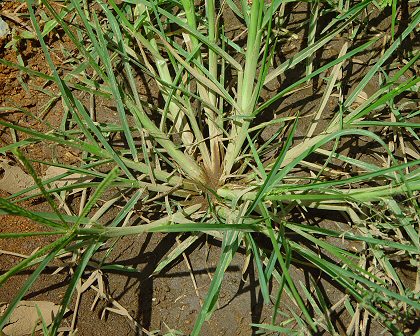Goosegrass
Scientific name:
Eleusine indica
Synonym: Bullgrass, Crow's foot grass, Goosefoot, Indian goose grass, Silver crabgrass, Wire grass
 Photo courtesy of Dan Tenaglia
Photo courtesy of Dan Tenaglia
Missouriplants.com
Habitat
Cultivated and uncultivated areas
Affected crops
Corn, upland rice, sweet potato, cassava, sugarcane, cotton, vegetables, soybean and other legumes, and other crops
Distribution
Worldwide
Description
The stem is erect, flattened, and branching, with smooth few long hairs along the edges. It is whitish or pale-green
in color. The leaves are smooth and dark-green with laterally flattened or folded blades. Mature leaves are very difficult to cut unless with very sharp farm implements. The flower head is windmill-like. The flowers are composed of 2 -10 flattened, finger-like spikes that look like a zipper, which emerge from a common point. The roots are strong and can easily grow in compacted soil. The weed is propagated by seeds and flowers the whole time. Each plant can produce up to 40,000 seeds.
Effects and impacts
Goosegrass can reduce yields for it competes with the main crop for water, nutrient, and sunlight uptake. It is an alternate host for tungro, ragged stunt, and rice yellow mottle diseases and for numerous insect pests like; aphids, armyworm, cutworm, hairy caterpillar, leaf folders, leafhoppers, mealybugs, plant hoppers, rice bugs, among others. Once established, this weed is difficult to eradicate (Rice IPM, 2001).
The weed, as studies show, is found to be resistant
to Paraquat on vegetables; Tluazifop-p-butyl and Glyphosate in orchards; and Fluazifop-p-butyl and Propaquizafop on croplands and vegetables in some parts of Malaysia (Weed Science, 2005).
Methods of control
- Proper seed selection
- Cutting the weeds (using sharp-bladed farm implements) before flowering, can reduce their population.
- Hand weeding of seedlings- it is difficult to do handweeding once the plant is mature and well-established due to its rough root system.
- Mulching (2-3 inches layer mulch) prevents the seeds from germinating. Germination occurs mainly on the soil surface. Seeds rarely germinate deeper than 8 cm.
- Proper plowing and harrowing before planting
- Regular field monitoring

